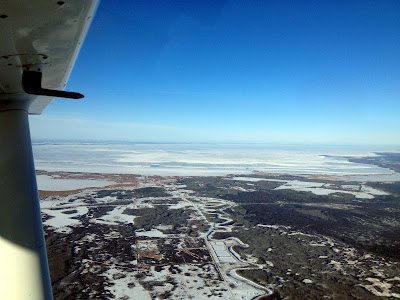Sights around Southern Manitoba
I mentioned a few days ago in my last blog entry that an important aspect of visual navigation by air is identifying familiar structures and the shape of the land. This blog entry will have a few pictures taken around the southern part of Manitoba; see if you can identify them before scrolling to the bottom of the page, where I'll list where the photos were created. I've been told by many of my passengers that their fear of heights doesn't give them anxiety in an aircraft; the world appears different and new when viewed from the sky, and maybe it's the detachment from the familiar that keeps people from experiencing the threat of falling to the ground below. A flight instructor once told me that their fear of falling from high isn't experienced in an aircraft because in the case of an emergency, we're not bailing out the windows; we'll fly that plane right to the ground and land somewhere safe.
2
3
4
5
6
7
8
9
Keep going to the bottom to find the info on each photo.
My flights have been sparse lately, as the main aircraft that I would tour with had been growing a list of problems. It must have been over 6 weeks ago that the auxiliary plug for music input had been broken and jammed into the console of the aircraft. Not a big deal. No more Frank Sinatra over the skies of downtown Winnipeg.
Not before long, the control for the flaps started sticking (imagine how a bird lands with its wings flared - that's basically what the flaps do.) That added some inconvenience to the situation, but we're still airworthy!
The transponder was the next thing to go. Now, not only is Frank Sinatra cancelled, our flights over Winnipeg are no longer authorized, because a transponder is required to propagate our altitude to the Winnipeg air traffic controllers.
Still revenue-worthy, the flight club keeps the aircraft in service, without changing anything.
We are airborne again a few flights later when the landing light fails and now becomes intermittent. Landings at night may or may not have a landing light to judge vertical depth to the runway.
Now things are getting a little ridiculous...
So instead I choose to do a flight in one of the two-seaters, a Cessna 152. Looking at the logbooks, it hasn't been flown in about a week and the gas tanks are nearly empty. Airplanes should be stored with full fuel to prevent moisture from condensing in the tanks. Water in the fuel is BAD. I ask for half tanks so that I won't drag down the runway overweight, but the mechanic fills them right to the top anyway.
Continuing my walk around, I notice that the engine oil is extremely low. Up until about 20 days before, a quart of oil had been added every second day, and none in the last series of flights. Seems like the previous renters had been running the engine dry. We topped up the oil and prepared for the taxi to the runway. I noticed that the right brake had been soft, but there hadn't been any oil on the ground to indicate a leak. Taxiing to the runway, everything is normal. I inform the tower that we're ready for takeoff, and he replies that we are approved for a backtrack if required, left hand turn out, cleared for take-off Runway 31. Brakes on, full throttle, RPM's are reading in the green power arc, upon releasing the brakes, we're rolling. I notice immediately that we're heavy. We are picking up significant speed though so we will get up to our climb speed at which we can safely rotate. "Woo! We're airborne!" says my passenger as we begin our gradual climb out. We turn crosswind to the south and then another left turn to fly parallel the runway towards Birds Hill Park. The engine shudders for a moment. "Did you feel that?" I say to my passenger. "Yeah what was that?" It happens again, and the engine sounds like its not going to make it another 5 minutes across the forest ahead of us. I call the tower and simply tell him that we're coming back for a full stop on runway 31 now. He clears us for landing immediately and we bank the plane over and get back to the ground safely. Taxiing the plane back to the apron (parking lot for airplanes) is all left turns, until the very last turn to the right. Without any right-side braking power left, we blow right through our turn and nearly off the side of the pavement. Doing a hard left-hand 360, I'm able to direct the airplane back to its parking spot and call it a day...and conclude flying with that flight outfit. Later in the day, the president of the club explained that it was a magneto failure; where the aircraft could have safely continued flight on its back-up magneto. Fortunately, there are alternate flight schools for back-up as well.
1. Highway #4's "Bridge to nowhere" in Breezy Point, MB
2. Cook's Creek in East Selkirk, MB
3. Gimli Harbor in... Gimli, MB
4. Birds Hill's Folk Fest 2012
5. Polo Park Shopping Center
6. Birds Hill's Man-made beaches
7. The Victoria Beach Pier
8. Stonewall, MB
9. Willow Island towards Gimli, MB










.jpg)













































